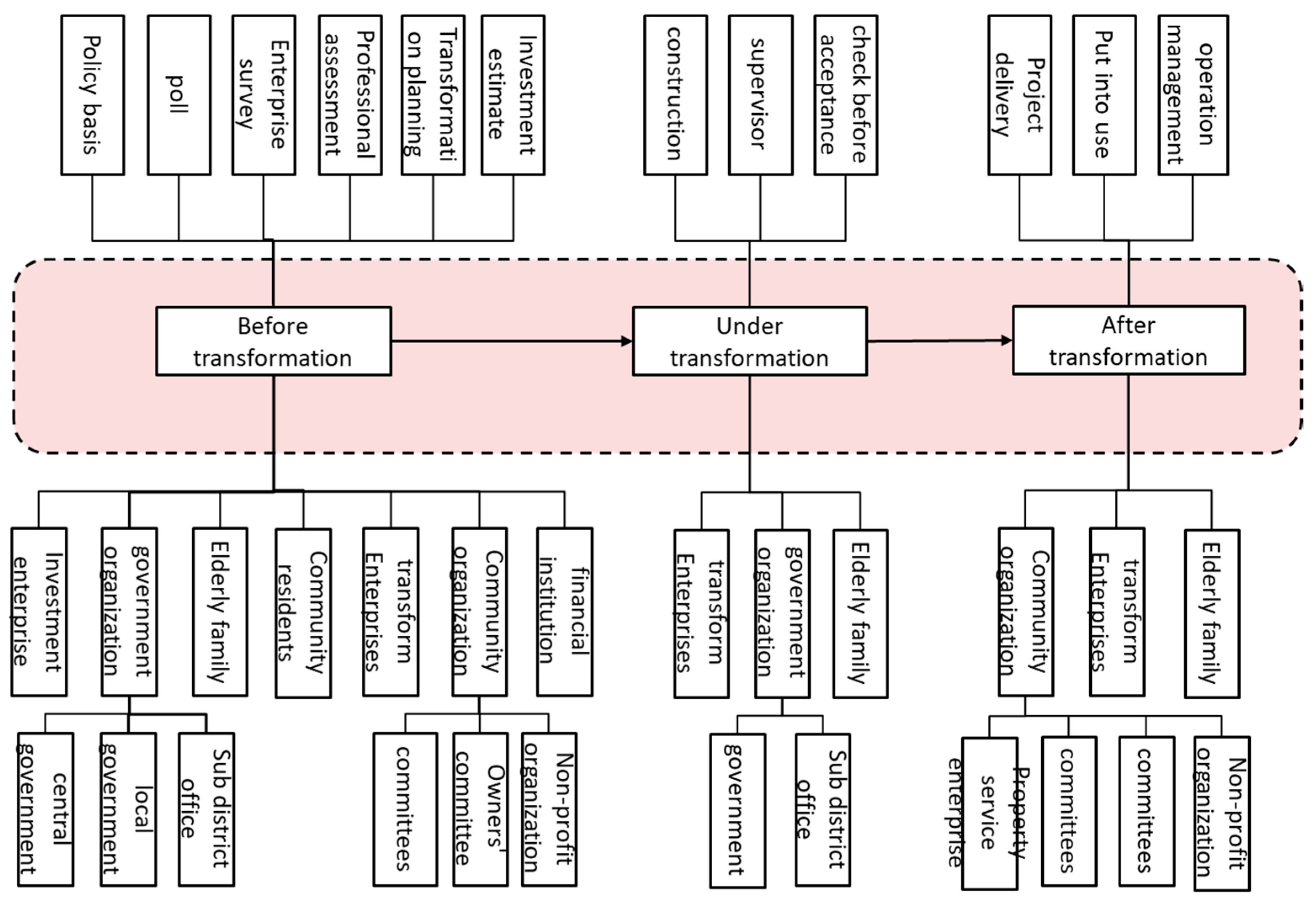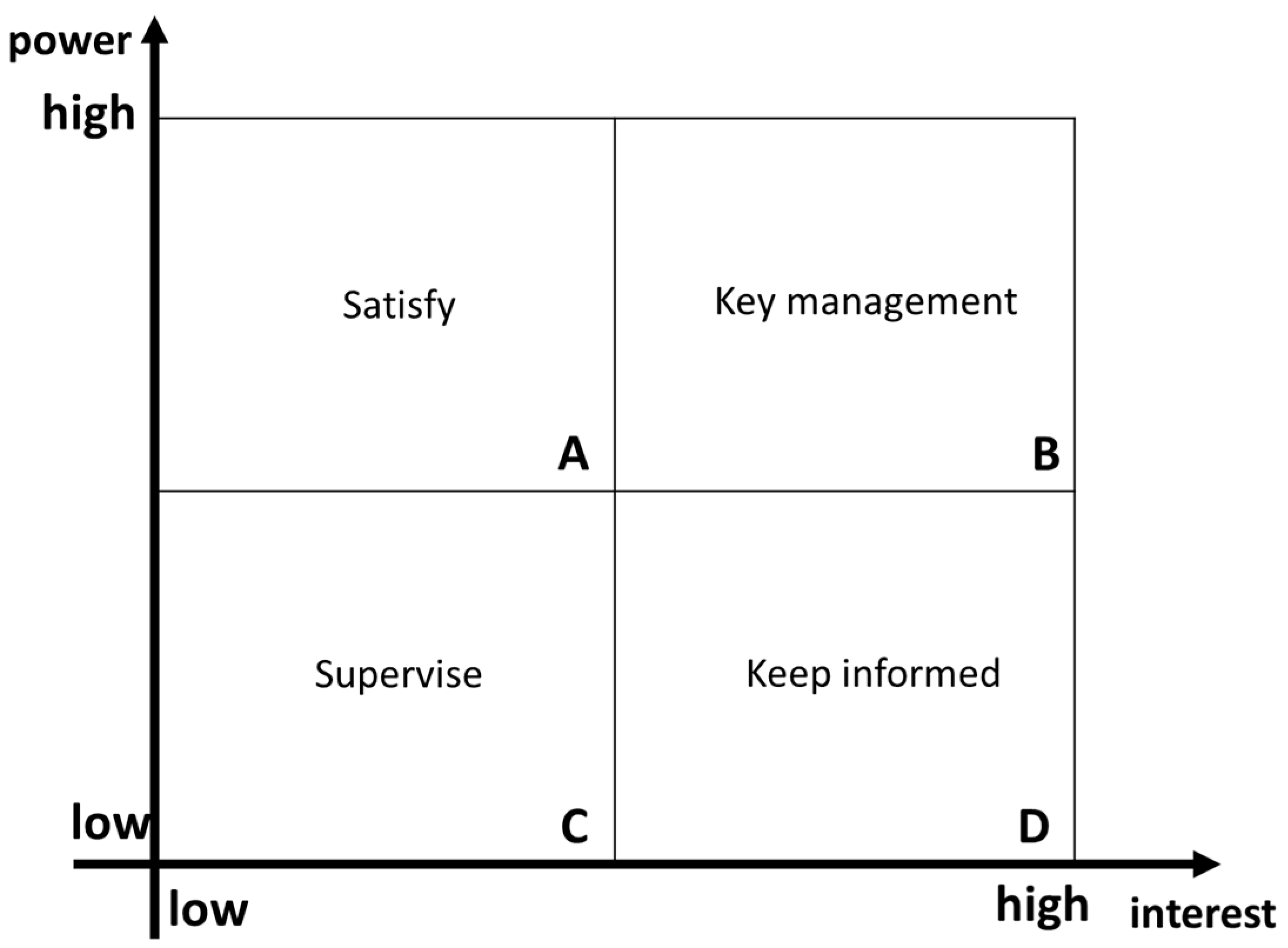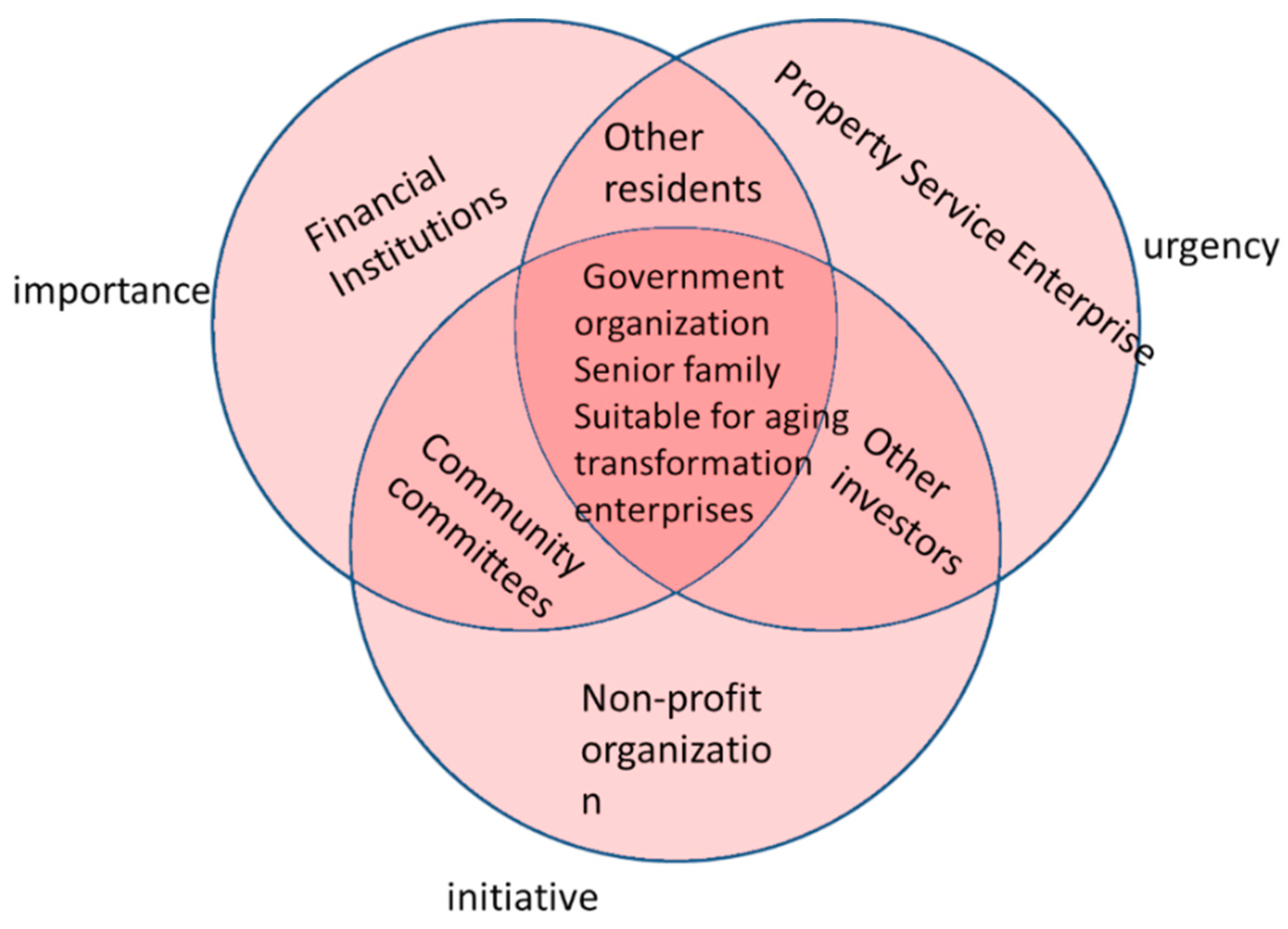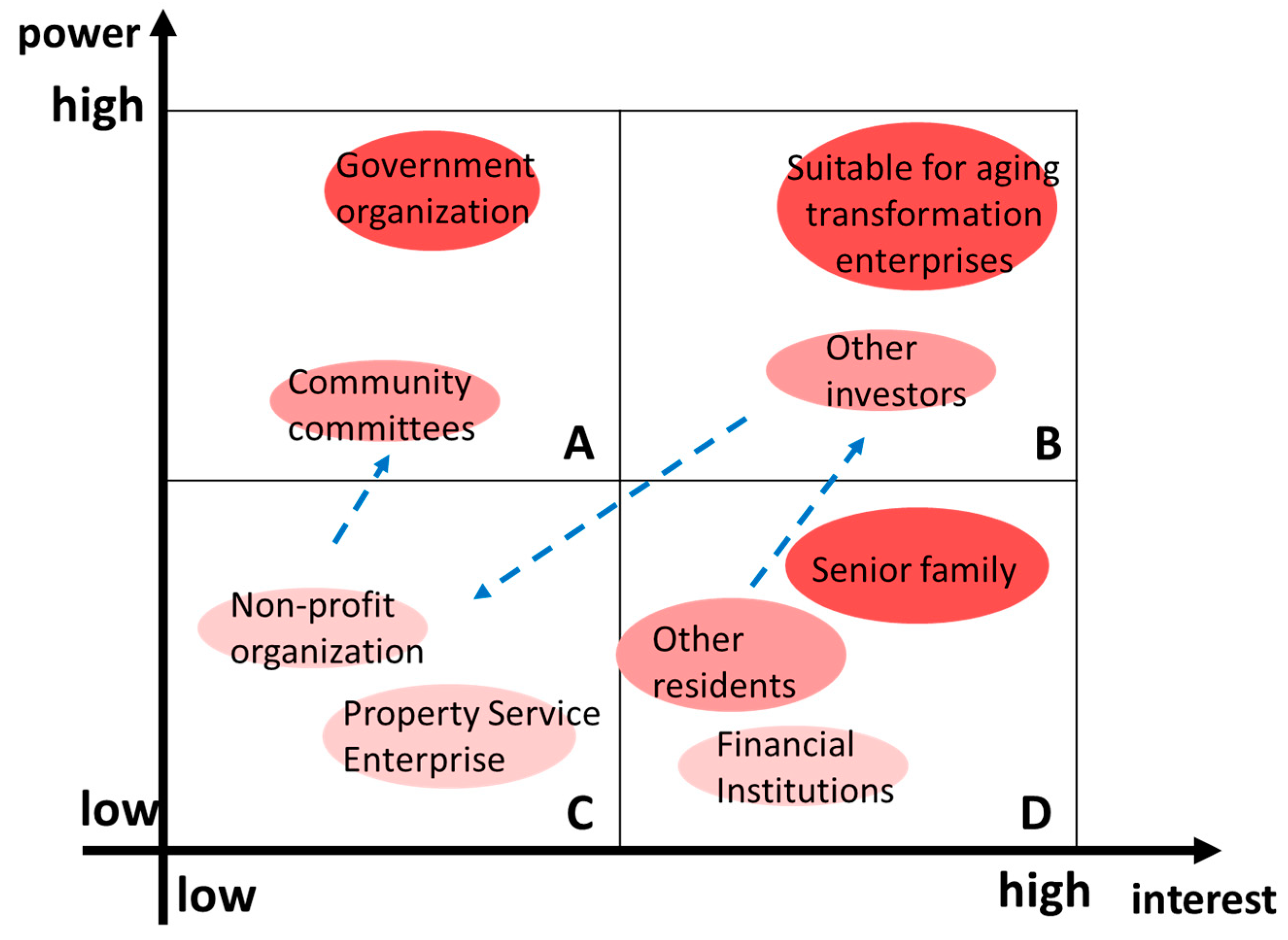Stakeholder Collaboration Mechanism in Elderly Community Retrofit Projects: Case Study in China
Abstract
:1. Introduction
2. Literature Review
2.1. ECRP Practices
2.2. Stakeholder Identification and Division Based on the Whole Process of ECRP
| Number | Stakeholders (Document Research Results) | Sources |
|---|---|---|
| S1 | Senior (elderly) family | [3,4,10,14,22,29] |
| S2 | ECRP companies | [2,22,27,30] |
| S3 | Government organisation | [2,3,14,22,27,30,31] |
| S4 | Community committees | [14,22,27,32] |
| S5 | Property Service companies | [22,27,33] |
| S6 | Non-governmental organisations/public welfare organisations | [10,22,30,31] |
| S7 | Financial Institutions | [28,31] |
| S8 | Other investors of the project | [33] |
| S9 | Other residents of the community | [14,30,31,32] |
2.3. Stakeholder Classification and Division Methods
3. Research Methodology
4. Findings and Discussion
4.1. Stakeholder Classification and Division Based on the Whole ECRP Process
- Core stakeholders (ageing families, government organisations, and ECRP companies) represent all three attributes (initiative, importance, and urgency) and represent the area intersected by all three circles in Figure 3.
- Dormant stakeholders (other residents, other investors, and community committees) mean that they only represent two attributes. For example, in Figure 3, other residents represent the area only intersects by circles urgency and importance, other investors represent the area only intersects by circles urgency and initiative and community committees represent the area only intersects by circle imitative and importance.
- Marginal stakeholders (financial institutions, property service enterprises, public welfare organisations) mean that they only represent one attribute. For example, in Figure 3, financial institutions only represent circle importance, property service enterprises only represent circle urgency and public welfare organisations only represent circle initiatives.
4.2. Development of Stakeholder Collaboration Mechanism Model
4.3. Discussion on Collaboration Mechanism Model
- Stakeholders in Area A: Area A includes government organisations and community committees. The stakeholders in this area have the highest power and certain interest. Their power is important to promote ECRPs. Particularly, community committees have the power to influence elderly people to accept ECRPs. Government organisations have significant power to establish ECRPs, as the policies issued by government organisations have an important impact on the other stakeholders in Area D. At the same time, because there are many levels of government organisations, they pay attention to internal government management, especially for street offices. Therefore, they can provide suggestions for local governments and the central government in order to revise the plans and policies to timely support ECRPs.
- Stakeholders in Area B: Area B includes ECRP enterprises and other investors. Stakeholders in area B have high power and interest. It is very important to consider the stakeholders in area B for possible strategies for the future development of ECRPs. If the interest of the enterprise and other investors is underestimated, they will immediately relocate into zone C. It will prevent the development of the ECRP industry to a certain extent.
- Stakeholders in Area C: Area C mainly includes community public welfare organisations and property service companies. Although their power and interests are low, they are the organisations closest to residents and elderly families. They can have relatively more influence on the daily life of elderly families. Appropriately, increasing their power will help them to move closer to area A.
- Stakeholders in Area D: Area D includes elderly families, other residents, and financial institutions. The stakeholders in Area D are mainly consumers who receive benefits from an ECRP. Whether or not the ECRP can be successfully implemented is closely related to their interests. Stakeholders in Area D do not have much power, but they can meet their needs in a timely manner through effective information communication, thereby promoting the concept of ECRPs. Promoting the stakeholders in area D to move closer to area B by increasing the power will increase their willingness to accept ECRPs and facilitate the cooperation between various stakeholders in the ECRP.
4.4. Suggestions for Core Stakeholders
- The incentive effect of government organisation:
- ECRP companies should actively establish an image of integrity:
- Active participation of elderly families:
4.5. Suggestions for Dormant Stakeholders
- Community neighbourhood committees should actively promote ECRP related work under the guidance of the government:
- Community residents should strengthen their communication mechanism:
- Other investors in the project should actively seek opportunities to support ECRPs:
4.6. Suggestions for Marginal Stakeholders
- NGOs/public welfare organisations need to improve their recognition:
- Financial institutions should actively stimulate the market vitality of ECRP:
- Property service companies should actively explore models suitable for operations and maintenance:
5. Conclusions
Author Contributions
Funding
Institutional Review Board Statement
Informed Consent Statement
Data Availability Statement
Acknowledgments
Conflicts of Interest
References
- Wu, L.; He, Y.; Jiang, B.; Sun, D.; Wang, J.; Liu, M.; Yang, S.; Wang, Y. Trends in prevalence, awareness, treatment and control of hypertension during 2001-2010 in an urban elderly population of China. PLoS ONE 2015, 10, e0132814. [Google Scholar] [CrossRef] [Green Version]
- Ruan, X.D. Home care for the elderly: Suitable for aging transformation ushered in the market outlet. New Econ. Guide 2017, 12, 67–71. [Google Scholar]
- Wang, S. A Study on the Willingness to Renovate the Housing of the Elderly in Shanghai’s Old Community. J. Econ. Res. 2019, 3, 129–130. [Google Scholar]
- Duan, L.; Gao, Y.; Liu, Y.; Tian, J. Investigation and Research on the Aging Level of the Old People’s Home Environment in Town and Community. J. Nurs. Sci. 2019, 34, 87–90. [Google Scholar]
- Bartolomeu, P.; Fonseca, J.; Santos, V.; Mota, A.; Silva, V.; Sizenando, M. Automating home appliances for elderly and impaired people: The B-live approach. In Proceedings of the 2nd International Conference on Software Development for Enhancing Accessibility and Fighting Info-Exclusion (DSAI’07), Villa Real, Portugal, 2007. [Google Scholar]
- Li, S.; Au Yeung, K.K.Y. Home modification programme for elderly home owners in Hong Kong. World Fed. Occup. Ther. Bull. 2016, 72, 54–57. [Google Scholar] [CrossRef]
- Yanli, Z. Elderly Residential Space Design and Analysis: A Review. In Proceedings of the International Conference on Advances in Mechanical Engineering and Industrial Informatics, Zhengzhou, China, 11–12 April 2015. [Google Scholar]
- Zou, C.; Li, R. Investigation and Suggestions on the Factors Affecting the Aging Reform of the Home Environment in the New Era Background. Urban Hous. 2019, 26, 40–43. [Google Scholar]
- Luo, J. Research on the “Adaptable Aging” Transformation of Old Residential Quarters. Mod. Property 2017, 1, 46–47. [Google Scholar]
- Li, C. Research on the Renovation of Elderly-Oriented Landscape in Old Residential Area of Shenyang Based on Comfort Optimization. Shenyang Jianzhu Univ. 2019, 26, 8–10. [Google Scholar]
- Li, C. Research on the Ageing Reconstruction of Old Multi-Storey Residential Units; Beijing Jiaotong University: Beijing, China, 2018. [Google Scholar]
- Zhu, X. Discussion on the needs of the expansion of the activity space of the elderly and the adaptation to the aging—A case study of the old communities in Xiamen. Green Technol. 2018, 21, 70–72. [Google Scholar]
- Chen, S.; Zeng, L.; Zeng, C.; Ma, C.; Li, H. Analysis on the needs of affordable housing for aging renovation and renovation design: Taking Nanjing as an example. Hous. Real Estate 2019, 12, 35. [Google Scholar]
- Gao, H. Research on Community Pension Planning and Design from the Perspective of Filial Piety Culture; Hunan University: Changsha, China, 2015. [Google Scholar]
- Guo, S. Reconstruction of Old Communities to Adapt to Aging under the Guidance of Differentiated Needs: Taking the Qingshan District Community in Wuhan as an Example. In Proceedings of the 60 Years of Planning: Achievements and Challenges—Proceedings of 2016 China Urban Planning Annual Conference (17 Housing Construction Planning), Shenyang, China, 24–26 September 2016. [Google Scholar]
- Ye, L. Investigation on “Potential Elderly Care Resources” in Rural Areas of Northern Zhejiang; Zhejiang University: Hangzhou, China, 2017. [Google Scholar]
- Sanford, J.A.; Butterfield, T. Using remote assessment to provide home modification services to underserved elders. Gerontologist 2005, 45, 389–398. [Google Scholar] [CrossRef] [Green Version]
- Andersson, G.; Karlberg, I. Integrated care for the elderly: The background and effects of the reform of Swedish care of the elderly. Int. J. Integr. Care 2000, 1, e01. [Google Scholar] [CrossRef] [Green Version]
- Hasson, H.; Arnetz, J.E. Care recipients’ and family members’ perceptions of quality of older people care: A comparison of home-based care and nursing homes. J. Clin. Nurs. 2011, 20, 9–10. [Google Scholar] [CrossRef]
- Luo, X. Aging Design for the Residential Space of the Elderly. Shanghai Arts Crafts 2019, 3, 89–91. [Google Scholar]
- Gao, L. Research on the Design of Outdoor Space Suitable for the Elderly in Old Residential Communities. Furnit. Inter. Decor. 2019, 8, 110–111. [Google Scholar]
- Zheng, L. A Study on the Ageing Reconstruction of Existing Commercial Residential Districts in Guangzhou; South China University of Technology: Guangzhou, China, 2016. [Google Scholar]
- Liang, X.; Shen, G.Q.; Guo, L. Optimizing Incentive Policy of Energy-Efficiency Retrofit in Public Buildings: A Principal-Agent Model. Sustainability 2019, 11, 3442. [Google Scholar] [CrossRef] [Green Version]
- Le, Y.; Zhang, B.; Guan, X.; Li, Y. Research on Collusion of Government Investment Projects Based on SNA Perspective. Public Manag. 2013, 10, 29–40. [Google Scholar]
- Liang, X.; Shen, G.Q.; Guo, L. Improving management of green retrofits from a stakeholder perspective: A case study in China. Int. J. Environ. Res. Public Health 2015, 12, 13823–13842. [Google Scholar] [CrossRef] [PubMed] [Green Version]
- Liu, Y.; Chen, B. Research on the Strategies for the Adaptability of Urban Existing Communities Based on Demand Analysis—Taking Suzhou City as an Example. Chin. Hosp. Constr. Equip. 2018, 33–36. [Google Scholar]
- Dai, X.; Wang, J.; Dong, B. Thoughts on the Reconstruction Mode of Guangzhou Old Community from the Perspective of Community Renewal. Shanghai Urban Manag. 2019, 29, 26–31. [Google Scholar]
- Zhang, T. The Value and Renewal Approach to Old Neighborhood and Residential Building Under “Double Aging”. Urban Archit. 2018, 21, 20–23. [Google Scholar]
- Zhang, J. Research on the Transformation of Urban Communities with Agrochemicals for the Old; Shandong Jianzhu University: Jinan, China, 2017. [Google Scholar]
- Xiong, Y. Research on Corporate Participation in Urban Community Governance from the Perspective of Stakeholders; Nanchang University: Nanchang, China, 2019. [Google Scholar]
- Wang, J. A Study on the Reconstruction of Urban Residential Districts for the Elderly under the Home-Based Care; Nanchang University: Nanchang, China, 2016. [Google Scholar]
- Wang, Y.; Wang, J. “Community Aging” Evaluation and Research on the Strategy of Community Aging Improvement. J. Tianjin Urban Constr. Univ. 2019, 25, 233–238. [Google Scholar]
- Chen, Y.; Tian, H. Research on the Countermeasures for the Reconstruction of Old Community under the Background of Community Elderly Care. J. Qingdao Technol. Univ. 2018, 39, 600–645. [Google Scholar]
- Qi, J. Research on Multi-Body Cooperative Control under Dynamic Evolutionary Game Mechanism; Wuhan University of Science and Technology: Wuhan, China, 2016. [Google Scholar]
- Zhang, Q. The Equilibrium Strategy of Enterprise Technology Innovation Based on Dynamic Evolutionary Game. Sci. Technol. Manag. Res. 2016, 21, 19–33. [Google Scholar]
- Guo, D. A Review of the Research on Classification of Stakeholders. J. Fuyang Teach. Coll. (Soc. Sci. Ed.) 2012, 15, 158. [Google Scholar]
- Zhao, N. Research on the Benefit Game and Optimization Strategy of Contractual Community Medical Service; Nanchang University: Nanchang, China, 2018. [Google Scholar]
- Chen, H.; Jia, S. Empirical analysis on three dimensional classifications of stakeholders in enterprises. Econ. Res. 2003, 4, 80–90. [Google Scholar]
- Freeman, R.E. Strategic Management: A Stakeholder Approach; Pitman Publishing: Boston, MA, USA, 1984. [Google Scholar]
- Frederick, W.C.; Davis, K.; Post, J.E. Business and Society: Corporate Strategy, Public Policy, Ethics, 6th ed.; McGraw-Hill Companies: New York, NY, USA, 1988. [Google Scholar]
- Adey, B.T.; Burkhalter, M.; Martani, C. Defining road service to facilitate road infrastructure asset management. Infrastruct. Asset Manag. 2019, 7, 240–255. [Google Scholar] [CrossRef] [Green Version]
- Charkham, J.P. Corporate governance: Lessons from abroad. Eur. Bus. J. 1992, 4, 8. [Google Scholar]
- Clarkson, M. A risk based model of stakeholder theory. In Proceedings of the Second Toronto Conference on Stakeholder Theory, Toronto, ON, Canada, May 1994. [Google Scholar]
- Clarkson, M.B. A Stakeholder Framework for Analysing and Evaluating Corporate Social Performance; The Academy of Management Review 20; University of Toronto Press: Toronto, ON, Canada, 1995. [Google Scholar]
- Mitchell, R.K.; Agle, B.R.; Wood, D.J. Toward a theory of stakeholder identification and salience: Defining the principle of who and what really counts. Acad. Manag. Rev. 1997, 22, 853–886. [Google Scholar] [CrossRef]
- Spens, K.M.; Kovács, G. A content analysis of research approaches in logistics research. Int. J. Phys. Distrib. Logist. Manag. 2006, 36, 374–390. [Google Scholar] [CrossRef]
- Guercini, S. New qualitative research methodologies in management. Manag. Decis. 2014, 52, 662–674. [Google Scholar] [CrossRef]
- Arifin, S.R.M. Ethical considerations in qualitative study. Int. J. Care Sch. 2018, 1, 30–33. [Google Scholar]
- Qian, Y.; Ren, H. Research on Stakeholders’ Joint Governance of Green Community Projects under the Public-Private Partnership. Urban Dev. Res. 2018, 25, 148–151. [Google Scholar]
- Geng, N.; Chen, Q. Analysis on the Behavior of Rural Environmental Management Stakeholders under the Benefit Game—Taking the Pollution Prevention and Control of Rural Livestock and Poultry Farming as an Example. J. Zhengzhou Univ. (Philos. Soc. Sci. Ed.) 2018, 51, 69–73. [Google Scholar]
- Jia, S.; Chen, H. Comment on the Definition Method of Stakeholders. J. Foreign Econ. Manag. 2002, 5, 13–18. [Google Scholar]
- Golant, S.M. Affordable clustered housing-care: A category of long-term care options for the elderly poor. J. Hous. Elder. 2008, 22, 3–44. [Google Scholar] [CrossRef]
- Sonal, S.; Anupadma, R. Revolutionizing Geriatric Design in Developing Countries: IoT-Enabled Smart Home Design for the Elderly; Wiley: Hobeken, NJ, USA, 2021; p. 193. [Google Scholar]
- Soar, J.; Croll, P. Assistive technologies for the frail elderly, chronic illness sufferers and people with disabilities—A case study of the development of a smart home. In Proceedings of the 18th Australasian Conference on Information Systems, Toowoomba, Queensland, Auatralia, 4 December 2007. [Google Scholar]
- Behr, R.; Sciegaj, M.; Walters, R.; Bertoty, J.; Dungan, R. Addressing the housing challenges of an aging population: Initiatives by Blueroof Technologies in McKeesport, Pennsylvania. J. Archit. Eng. 2011, 17, 162–169. [Google Scholar] [CrossRef]




| Author/s | Division Factors | Stakeholder Classification | Method |
|---|---|---|---|
| [39] | Stakeholder resources | Ownership, economic dependence, social benefits | Multidimensional subdivision |
| [40] | How stakeholders can influence the company | Direct and indirect stakeholders | Multidimensional subdivision |
| [41] | Cooperative and threatening | First and second level stakeholders | |
| [42] | Whether there is a transactional contract | Contractual and public stakeholders | Multidimensional subdivision |
| [43,44] | The type of risk taking; close contact with the enterprise | Voluntary and involuntary, primary and secondary stakeholders | Multidimensional subdivision |
| [45] | Legitimacy, power, urgency | Identified, expected, and potential stakeholders | Mitchell scoring |
| [38] | Initiative, importance, and urgency | Core, dormant, marginal stakeholders |
| Number | Filename |
|---|---|
| 1 | ‘Notice of the State Council on Printing and Distributing the Construction Plan for the Elderly Care System for the Development of the Aged Enterprise’ in the ‘13th Five-Year Plan’—Guo Fa (2017) No. 13 |
| 2 | ‘Notice of the Ministry of Civil Affairs and the Ministry of Finance on the Central Financial Support for the Pilot Work of Reforming Home Pension and Community Pension Services’—Minhan (2016) No. 200 |
| 3 | ‘Opinions of the National Working Committee on Ageing on the implementation of the ‘13th Five-Year Plan for the Development of the National Ageing Undertaking Development and Pension System’ member unit division of labour’—National Committee on Ageing (2017) No. 6 |
| 4 | ‘Opinions of the General Office of the State Council on Formulating and Implementing Elderly Care Services Projects’—Guobanfa (2017) No. 52 |
| 5 | ‘Notice on the Implementation of the 2019 Age-appropriate Renovation Project for Urban Empty Nest Old Family’ |
| 6 | ‘Notice of Wenzhou Ouhai District People’s Government Office on Decomposing and Implementing the Top Ten Practical Matters for the Ownership of Ouhai District in 2017’—Wen Ou Zheng Fa (2017) No. 56 |
| 7 | ‘Pilot Implementation Plan for the Ageing Improvement Project for the Families of the Elderly in Need’ |
| 8 | ‘Notice on Doing a Good Job of Renovating Old Towns in 2019’ |
| 9 | ‘Beijing elderly households’ needs for ageing reconstruction needs assessment and reform implementation management measures (trial implementation)’ |
| 10 | ‘Guiding Opinions on Promoting the Construction of a Liveable Environment for the Aged’—National Office for Ageing (2016) No. 73 |
| Number | Stakeholders | Data Collection Method | Number of Interviews |
|---|---|---|---|
| S1 | Senior family | Interviews | 153 |
| S2 | ECRP companies | ECRP company-related corporate website information | |
| S3 | Government organisation | Government documents related to policies and standards | |
| S4 | Community committees | Interviews | 31 members on 6 committees |
| S5 | Property Service Enterprise | Interviews | 36 employees in 8 companies |
| Number | Stakeholders | Initiative | Importance | Urgency |
|---|---|---|---|---|
| S1 | Senior (elderly) family | medium | high | high |
| S2 | ECRP companies | high | high | high |
| S3 | Government organisation | high | high | high |
| S4 | Community committees | medium | high | low |
| S5 | Property Service Enterprise | low | low | medium |
| S6 | Non-governmental organisations/public welfare organisations | medium | low | low |
| S7 | Financial Institutions | low | in | low |
| S8 | Other investors of the project | medium | low | medium |
| S9 | Other residents of the community | low | medium | medium |
Publisher’s Note: MDPI stays neutral with regard to jurisdictional claims in published maps and institutional affiliations. |
© 2021 by the authors. Licensee MDPI, Basel, Switzerland. This article is an open access article distributed under the terms and conditions of the Creative Commons Attribution (CC BY) license (https://creativecommons.org/licenses/by/4.0/).
Share and Cite
Guo, L.; Hao, S.; Ranasinghe, U.; Tang, M.L.; Hardie, M. Stakeholder Collaboration Mechanism in Elderly Community Retrofit Projects: Case Study in China. Sustainability 2021, 13, 10759. https://doi.org/10.3390/su131910759
Guo L, Hao S, Ranasinghe U, Tang ML, Hardie M. Stakeholder Collaboration Mechanism in Elderly Community Retrofit Projects: Case Study in China. Sustainability. 2021; 13(19):10759. https://doi.org/10.3390/su131910759
Chicago/Turabian StyleGuo, Li, Shuya Hao, Udara Ranasinghe, Maggie Liyaning Tang, and Mary Hardie. 2021. "Stakeholder Collaboration Mechanism in Elderly Community Retrofit Projects: Case Study in China" Sustainability 13, no. 19: 10759. https://doi.org/10.3390/su131910759
APA StyleGuo, L., Hao, S., Ranasinghe, U., Tang, M. L., & Hardie, M. (2021). Stakeholder Collaboration Mechanism in Elderly Community Retrofit Projects: Case Study in China. Sustainability, 13(19), 10759. https://doi.org/10.3390/su131910759








